A rainy season journey: grasshopper road trip to Fort Portal
Our dawn departure from Kampala is marked by streaks of pink and orange daybreak filtering over Port Bell and Lake Victoria. Houselights twinkle in the darkness. Kampala is so pretty at this time of day.
We are driving to Fort Portal. Along Hoima Road, a traffic policeman dressed in white leaps out into the road to intercept a passing saloon car that has large white canvas sacks billowing out of every window.
An excited Julia shouts “nsenene!”
Grasshoppers are back on the menu!
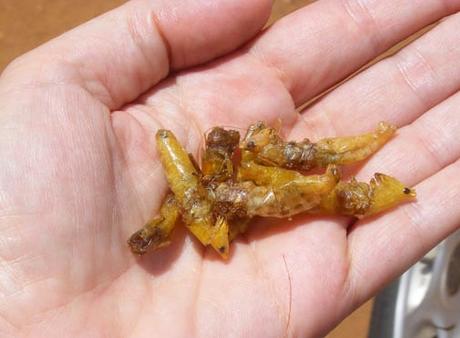
A handful of cooked ‘nsenene’ grasshoppers Entebbe. Did I enjoy them? (Scroll down…)
It’s rainy season and there is a glut of nsenene (grasshoppers). The sacks contain live insects that are hung out of the window of the moving vehicle to keep them cool as they are transported to Kampala markets. Ugandans are going crazy for the delicacy, with queues of people lining up downtown to buy them.
Vehicle after vehicle drives towards us laden with white canvas sacks.
It’s 7 o’clock on a November morning.
Julia recounts the story of the day she bought a quarter sack of nsenene as she travelled back to Kampala. The kids were screaming with excitement at the thought of feasting on them. Grasshoppers do not have a long shelf life. They have to be ‘cleaned’ (their wings and legs removed) before they can be washed and cooked. Everyone arrived home from the long journey exhausted, she said, but then had to spend several hours plucking off wings and legs! “I think everyone was too sick to eat them after that!”
I remember opening the fridge the next day to find it full of grasshoppers (in addition to the chicken feet and cow hooves reserved for the dog!)
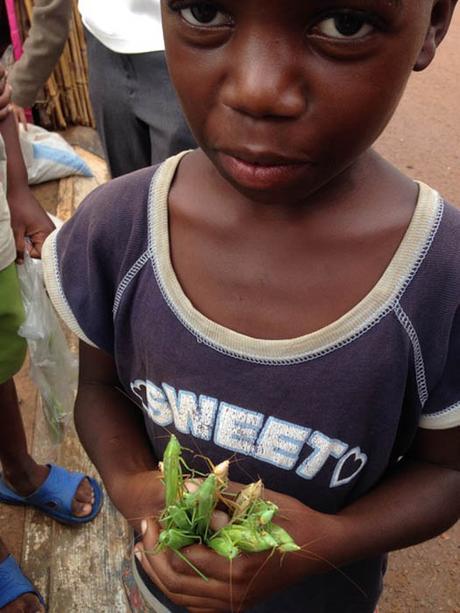
I adore this photo – a young boy delicately holds a bunch of live nsenene grasshoppers Mubende. PHOTO Malcolm Wilson
On our journey, Malcolm likes reminding us that Julia was a full-on vegan when they first knew each other many years ago on the Mweya Peninsula in Queen Elizabeth National Park. Back then a grasshopper would not have passed her lips.
At a small trading centre we see some lovely looking chapatis. “Let’s stop for a rolex,” Malcolm says. Everyone loves a rolex. The popular Ugandan street food (of an omelette wrapped in a chapatti) has gone global this year (thanks to an article called ‘The African dishes you should be eating’ on CNN.com)
Our car pulls up next to an open-air butchery. Next to the car, the butcher hacks at a lump of meat with a machete. His face is covered with tiny flecks of meat. Big slabs of beef hang on hooks, intestines lie glistening on a table.
“I’m just going to get some cow hooves for the dogs,” Julia informs me. (Barf. Did you need to tell me? I beg).
As she walks towards the butcher, she stumbles over the head of a recently butchered cow. It sits upside down on the muddy ground, bright red blood draining onto the dark floor. A man straps the cow’s head to the back of his bicycle and wheels it away.
Malcolm gets back into the car frustrated. “That guy has a chapati, the other guy has eggs, but no-one can make me a rolex!” He is on a mission. He decides to return to the stall and get the vendors organised.
Meanwhile, I should not be surprised to see Julia instruct a man to tie a bag of grasshoppers onto the front of our vehicle!

In Mubende, a small sack of live nsenene is fixed to the front of our car
A woman rushes over with a basket of roasted gonja (bananas) on her head. A young man walks up to our parked car and shows me a gold coin. He asks me how much I want to buy it for. He’s trying to sell the muzungu a 20 cent Euro coin. (I wonder if he’s been asking every passing muzungu to buy it).
A happy Malcolm gets back into the car with three monster-sized rolex. The chapatis are thick and well-cooked. They are delicious! We are ten minutes south of Mityana.
“One, two, three, four, five, six, seven, eight, nine, ten, eleven, twelve!” Malcolm counts twelve Great Blue Turacos. “They must have just come out of roost,” he says (meaning the birds have just left their overnight perch).
As we continue our journey towards Fort Portal, more cars come towards us, overloaded with grasshoppers.
“I could carry three sofa sets on the roof of my car today and none of the traffic police would notice!” Exclaims Julia. This morning, the traffic police are only interested in watching the vehicles heading to Kampala.
En route we talk about birds, we talk about conservation, we talk about the many poacher snares and traps that have been recovered by Uganda Conservation Foundation and Uganda Wildlife Authority.
Last time I drove this road I had to slam on the brakes to avoid crashing into a cow that walked straight into the road without looking (it seems to be a Ugandan trait!)
We pass lines of bright shiny corrugated iron sheets, set in horizontal lines to catch grasshoppers. The insects are attracted by a bright light bulb that reflects onto the metal. The insects crash into the metal sheets and land in the buckets at the bottom.
At Mubende, we pull over for Julia to buy some fried grasshoppers and mbuzi roasted ‘goat on a stick’.
“That’s baboon meat!” Shouts Malcolm.
“It’s not baboon!” Laughs the meat-seller.
A man selling water and sodas bangs on the window and tells me to put the window down. I bang back at him angrily. He gets the point and we smile at each other through the glass.
I spot three Hooded Vultures at the top of a tree “the ones with pink necks” I say. “The pink bits are called caprophages” Malcolm corrects me.
Driving through Kiko tea estate, outside Fort Portal, thousands of grasshoppers float above the bright green tea bushes like a layer of green mist. The emergence of grasshoppers floats above the tea and up into the air.
A troupe of eight black and white Colobus Monkeys sit at the top of a tree in a clearing next to the tea plantation. I’m surprised to see them in such an open area. “They do very well in disturbed forest,” Julia – the primatologist – tells us.
We are travelling to Kanyanchu where Julia’s land touches Kibale Forest. For many years she lived in a treehouse in the middle of the forest while she followed, studied and habituated the chimpanzees that are now so popular with tourists.
Malcolm grabs his binoculars to take a closer look at large flocks of Abdim Storks that are circling high in the air, to our left and to our right. “Must be thousands of them,” he says.
According to The Birds of East Africa, Abdim Storks are “nomadic and gregarious.” They are seen in Uganda between October and November as they follow “the rains and burns” on their flight from northern Africa. They are known as “opportunistic” feeders and are undoubtedly making the most of the grasshopper season.
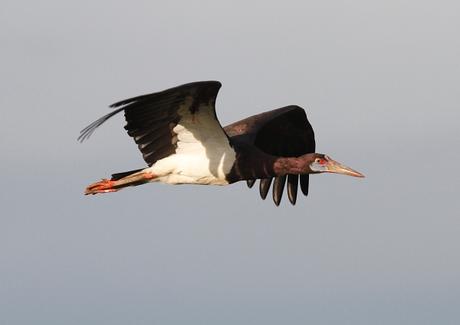
Abdim’s Stork in flight, Tanzania. PHOTO Jonathan Rossouw
We talk about migration and Malcolm explains how birds use thermals to cover vast distances. “You will notice that vultures are never in the air at the start or the end of the day. They need the hot air rising off the land to allow them to climb high. Vultures can go up 1 or 2 km and then slowly guide for 400 miles. Doing this, they expend very little energy.”
He tells us about a Ruppell’s Griffon Vulture that was seen 12 km above the surface of the earth by a commercial pilot. Vultures have incredible eyesight and watch each other from up on high. I like hanging out with Malcolm. Not only can he identify a bird, he has a mine of fascinating facts to explain what we’re looking at. Vultures watch each other carefully to see when one will drop. “A vulture only drops for one reason: a kill. When one drops out of the sky, the others follow.”
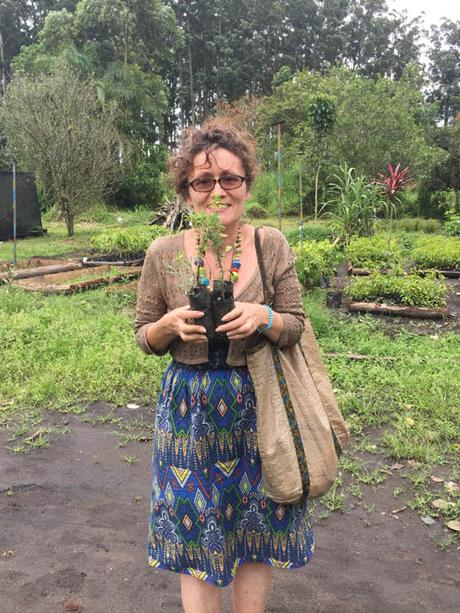
It’s fun buying plants at Tooro Botanical Gardens in Fort Portal
At Tooro Botanical Gardens, a young man called John guides us through the various plants, telling us both the English names and the Latin names. With John’s help, Malcolm and Julia pick out a selection of tree seedlings. Julia and I share a moment of realisation. Julia has been wanting to invite Malcolm to advise her on which plants and trees will help develop her land for birding tourism. Finally we are here. This weekend has been many years in the planning. I am so excited to be part of it.
There is a small fishpond in Tooro Botanical Gardens. It hasn’t been stocked with fish yet but there’s already a heron inspecting it. Julia correctly identifies it as a Black-headed Heron. The girl’s birding knowledge is coming on!
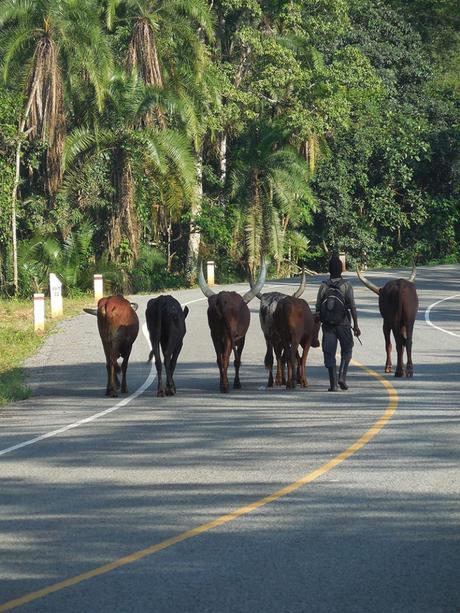
Walking cows along the new road through Kibale Forest
We drive on the new road through Kibale. The Chinese (of course) construction company have been working on it for a couple of years. It’s a good road in many respects but too wide. We bemoan how big and fast the road is. It passes directly through Kibale Forest National Park, described as having “the highest concentration and density of primates in Africa.” We are worried how many of the forest’s animals will be killed by speeding motorists. There are a few road humps but nowhere near enough. We hope and pray that the speed humps will proliferate.
Our car passes through a troop of baboons. One stands on its two back legs to peer into the car looking for food.
I am appalled to see that one of them has had its whole snout (large pointed nose and lips) are missing. Its normally 3D face is flat. His front teeth are permanently visible but beyond this appalling wound, the animal looks healthy enough. Will he survive?
Another baboon, in the bush above the verge, picks at something that it holds in its right paw. It appears to be an animal skin. The baboon pulls the last bits of flesh off some skin “it’s most likely a vervet monkey,” Malcolm says.
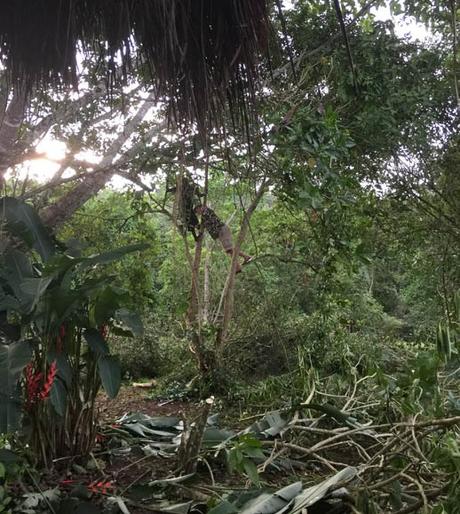
Can you spot them? Innocent gets a lesson in tree cutting from Malcolm Wilson at Sunbird Hill, Kibale
At our final destination, Sunbird Hill, Malcolm teaches us all about tree felling and the best plants to attract more birds to the forest edge. It’s an enlightening few days.
If you enjoy grasshopper stories, read Grasshoppers – nsenene: eat them or smoke them? Discuss.
« Rwanda announces: all travelers to get #VisaOnArrival from January 2018

